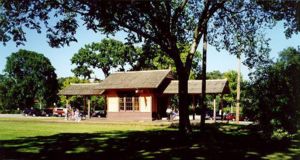Minnesota Transportation Museum

The Minnesota Transportation Museum (MTM) is an organization that operates several heritage transportation sites in Minnesota and just across the border in Wisconsin. The museum primarily focuses on preserving and restoring portions of the railroads and buses that once traversed the area. The organization was first formed to save a streetcar that had been built and operated by Twin City Rapid Transit (TCRT) in the Minneapolis-St. Paul region of Minnesota. The museum was officially organized in 1962, and followed in the footsteps of the Minnesota Railfans Association, which had organized railfan trips in the 1940s, '50s, and '60s.
In 2004–2005, the organization's streetcar operations were spun off to form the Minnesota Streetcar Museum. In addition, a steamboat that was originally built by TCRT in a style similar to its streetcars was split off to start the Museum of Lake Minnetonka.
Contents
Minnehaha Depot
After the first streetcar, TCRT #1300, was successfully restored, other projects were examined in the time before the streetcar could be put on its own set of rails. The Minnehaha Depot was a Milwaukee Road depot at Minnehaha Falls. The station, built in 1875, was nicknamed "The Princess" because of its delicate architecture. Trains running on special routes have sometimes stopped at the station, and it was eventually integrated into the area streetcar system. Tracks owned by the Canadian Pacific Railway reach the station, though it is at the disused end of a rail spur. In 1967, this was the first building restored by the museum and outfitted with exhibits inside. Today, the Hiawatha Line station serving Minnehaha Park is located across the road from the old depot.
Classic buses
A few buses from the 1940s and 1950s are also operated by the museum. Most of the buses in the collection were built by the GMC division of General Motors, and represent the vehicles that replaced the streetcars in the Twin Cities. There is also a Mack-built bus, and a Yellow Coach dating to 1935 that once operated in Rochester, Minnesota, but it has not been restored.
As the museum has acquired much of its bus collection from Metro Transit, the bus company sometimes requests the use of the old buses for special events.
Osceola and St Croix Valley Railway
There were several attempts by the museum to venture into the world of steam power in the 1970s and 1980s. After several false starts, largely due to community opposition to the idea of noisy locomotives trundling by, the museum finally managed to start up a train system along with the historical society of Osceola, Wisconsin. This location is about an hour away from the Twin Cities. Trains operate on track owned by Wisconsin Central Ltd., currently a subsidiary of Canadian National.
A number of locomotives and pieces of rolling stock are in operation. Most of the locomotives that are currently in running condition are diesel-electric, although steam locomotives have occasionally been used to pull the trains. Many are currently undergoing restoration work.
The train route runs past several train depots that have been restored by MTM. They include stops in Copas, Minnesota, Dresser, Wisconsin, and the main station in Osceola. The northern end of the line is in Dresser, and the southern end is in Marine on St. Croix, Minnesota.
Jackson Street Roundhouse
The main base for the museum is the Jackson Street Roundhouse in St. Paul. It is the site where the large locomotives and rolling stock come for maintenance and restoration. There are currently some small exhibits at the roundhouse. The building was put up by the Great Northern Railroad in 1907 and is on a site that has been used for rail transportation ever since trains first came to Minnesota. For a time, the building was used as a warehouse, but the turntable has now been restored and track laid to allow restoration activities to take place.
